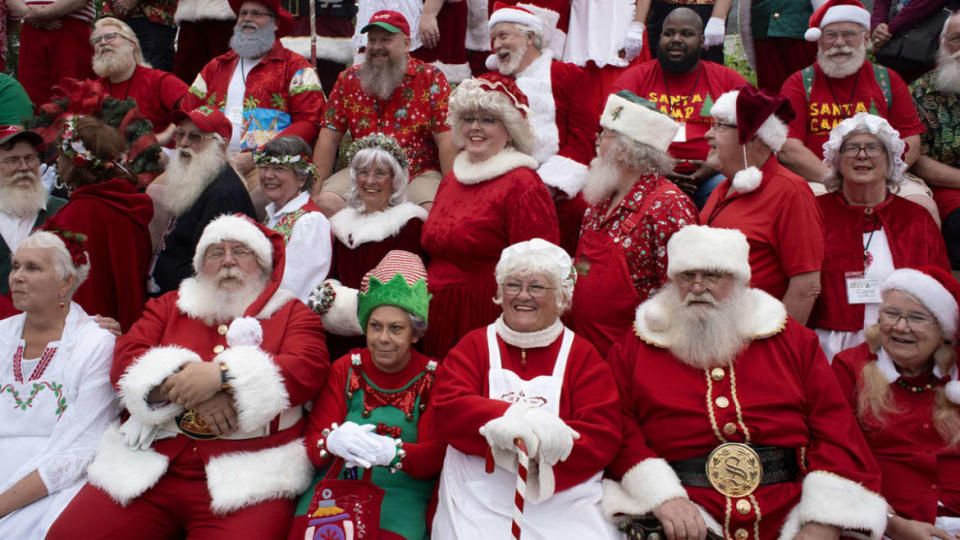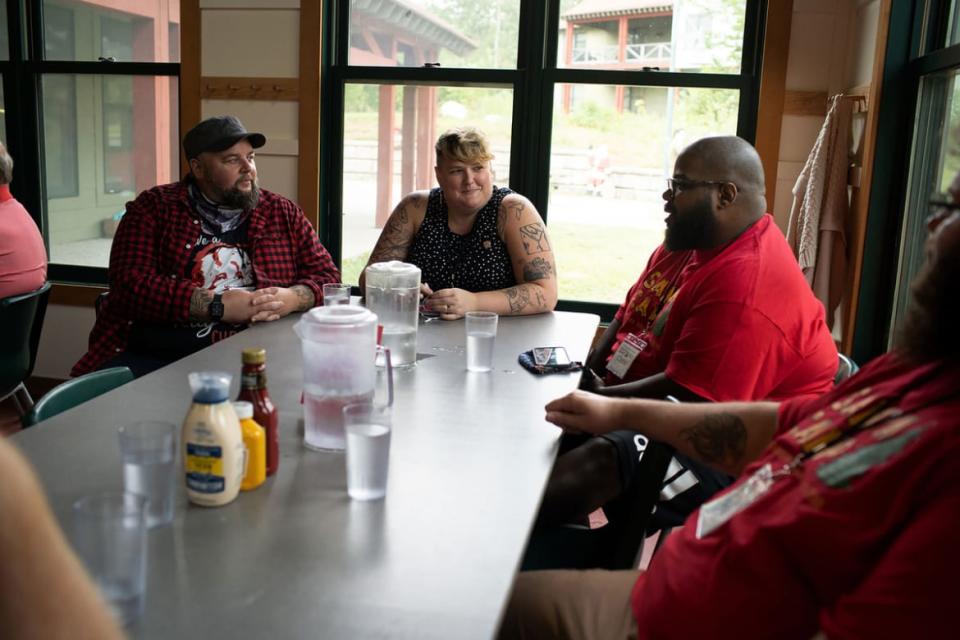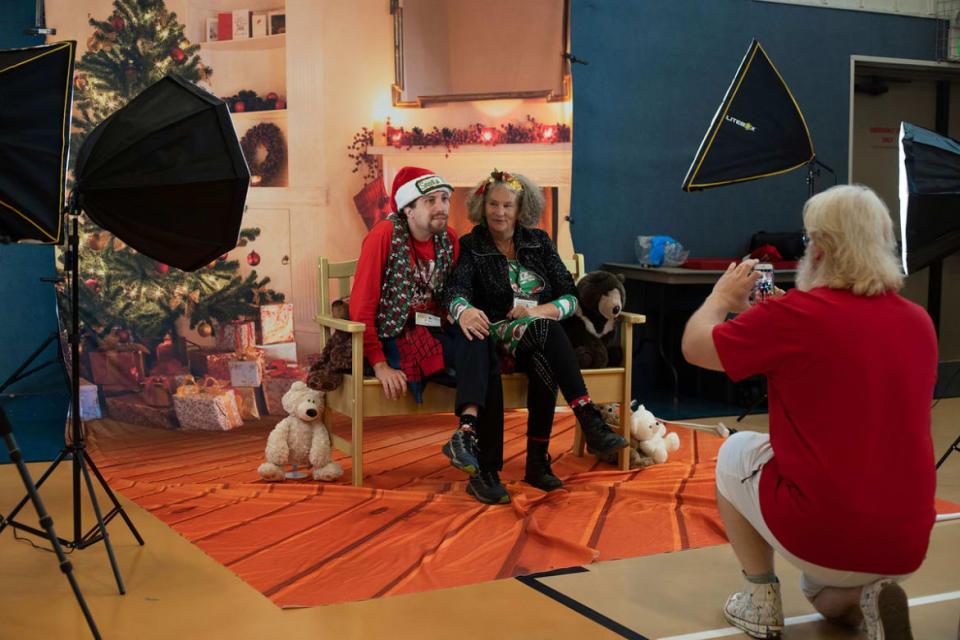Does Santa Claus Have to Be White? A Jolly New Doc Says No

Every year on Christmas Eve, my dad dresses up as Santa to visit the kids in our extended family. It’s a tradition first started by his brother—also an older white guy—who was the first to throw on the scratchy beard, black vinyl boots, and bright red coat and hat. The costume was convincing enough, but oftentimes the freezing conditions of a Minnesotan December snowscape resulted in them trying to cover their faces as much as possible, bringing the beard and hat together in one seamless line. All that was left were two eyes poking out beneath them.
We couldn’t tell if it was a man, woman, large bird, or three rascally kids standing on top of each other’s shoulders under that suit. But it didn’t matter. Santa is not a person, he’s a symbol. He arrives every year to remind kids that being a good person is the most rewarding thing one can do in life. Hell, if you boil it down, Santa Claus is really just a child-rearing tactic.
But like everything tangentially related to the holiday season—from red coffee cups to wars on religion—Santa has become a hot-button issue. For a certain sect of Americans, it’s their mission to rally against an ever-changing world pushing for progression. That deafening objection and the people who dare to defy it are the subjects of Santa Camp, a new documentary streaming Friday on HBO Max.

The film follows the New England Santa Society, which makes an annual pilgrimage to a New Hampshire campsite to brush up on the tricks of their trade. Unlike every other year, when Santa Camp is packed to the brim full of fat, jolly, old white guys, the Society is making an effort to address a historic problem, only growing more pertinent: the lack of diversity among their tight-knit group of merry men.
As Megyn Kelly’s infamous (and incorrect) assertion that Santa must be white continues to proliferate, Santa Camp might be the definitive answer to the question, “Why do hundreds of years of tradition need to change?” And while the film can’t always overcome its own overt desire to be impactful, it’s still a fascinating dissection of humanity’s habitual nature and a necessary glimpse at all of the good that comes from breaking those molds—one that everyone, old and young, should see this season.
Santa Camp introduces us to three unique Santas, each one working against the Santa Claus typecast for their own reasons. There’s Chris, a Black Santa, who has decided to take up the mantle for his daughter and his community after receiving hate mail when he put up a Black inflatable Santa in his yard; Fin, a Santa with spina bifida, who has grown attached to what the character symbolizes and dreams of riding in a holiday parade to inspire others; and Levi, a trans Santa, who wants young people to understand that seeing yourself represented in the world is a powerful tool for self-discovery.
The 19 Best (and Cheesiest) Holiday Movies to Stream This Year
The film lets us sit with each of these three Santas, allowing us the grace to understand why this dream has become so important to them. Interspersed with their preparations for Santa Camp are meetings with the New England Santa Society, which is making arrangements of its own to accommodate these new Santas. This means trying to address their own biases, breaking them down so that camp can run smoothly. Chatter about cancel culture and our long-standing perception of Santa is eventually broken up by a seasoned Santa named Richard—the Santa soothsayer, if you will. “It just doesn’t matter,” Richard says about the complaints about new Santas that look different than their group joining the group. “As the oldest person here, it was hard to accept in my generation that God created no junk. And God created no junk.”
When camp begins, it becomes apparent that not everyone is quite as prudent. We watch as the Santas clumsily stumble through their interactions with Chris and Levi, making needless comments about Chris’ skin color and Levi’s insistence to use his pronouns when introducing himself. “Being the only person of color here [is] definitely lonely and awkward,” Chris tells the camera, as we see him walk past group activities and old friends without anyone offering so much as a glance. Most of the Santas have a near-palpable fear of being judged, even “canceled,” for saying the wrong thing, and it’s increasingly strange to see new members othered in a group that has gathered to celebrate their love of a mystical, milk-and-cookies-loving fat guy.
Meanwhile, Fin, who has the most to physically overcome at camp, is welcomed with open arms. He’s got his mother along with him and an iPad to help him convey speech. It’s both fascinating and wholeheartedly depressing to see him accepted with all the jolliness one would come to expect from a group of Santas, simply because he’s a white guy. And though the group warms up to Chris and Levi as well by the end of the camp’s session, it’s frustrating that three of these unique Santas have to dump their traumas on this Santa Society, just to make the other Santas understand why this is so important not just for them, but for others like them.

The primary intention of Chris, Levi, and Fin is not to push any of the false agendas that the bigots who target them have made up. Rather, it’s to make space for themselves in the world. As Levi very astutely puts it, children look at Santa and see the hope for a boundless future, one where Christmas wishes can come true. They can see themselves happy with the things they really want, maybe the things they’re too afraid to express to anyone but the friendly guy in the bright red suit.
Santa is an emblematic figure, who represents the idea of Christmas as a beautiful time of year that’s about coming together and celebrating each other for who we are. Santa isn’t merely an omnipotent dude who stuffs his ass down your chimney once a year and steals all your sweets—he’s a picture of Christmas as a force for good. He wants us to be good because he believes in the good of the world! It’s why he’s been doing this for so long, and why the myth of his existence still persists.
The fable of Santa Claus dates all the way back to Saint Nicholas in the fourth century. Saint Nicholas was a nonwhite bishop, who eventually moved through Christian lore and modern media to become the fur-trimmed, red-suit-wearing, white-bearded Santa we know today. Santa has evolved countless times before, across borders and through cultural folklore—why can’t he do it again? Santa Camp practically begs us to remember that evolution is a natural part of the human condition, pondering why we’re so attached to one single perception of an imaginary man when the tenets of the holiday he represents are founded in love and inclusion.
Santa Camp rounds itself off with sufficient style—there are scenes montaged to Donna Summer and Enya!—and a few sincere, hearty laughs. Scene stealers, like an outspoken Mrs. Claus named Dianne, who demands equal pay at gigs because she’s “not just a warm-up act,” and Fin’s kindhearted mother Suki, buoy the film by showing us how easy is it to champion diversity from both inside and outside of the status quo.
And though parts of the film—specifically the Santas’ post-camp public detractors—do occasionally feel artificial, it almost doesn’t matter. It’s inspiring to see the bravery on display here. Witnessing firsthand the positive effects of making space for representation is a critical tool in making progress. And what better time is there for a little improvement than the holiday season? After all, Santa’s always watching.
Get the Daily Beast's biggest scoops and scandals delivered right to your inbox. Sign up now.
Stay informed and gain unlimited access to the Daily Beast's unmatched reporting. Subscribe now.
